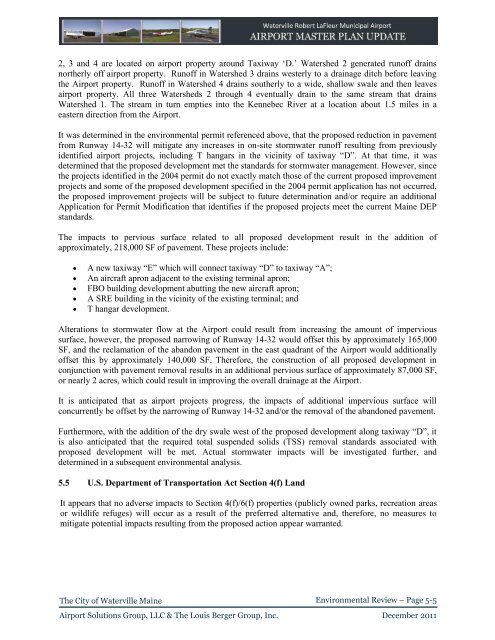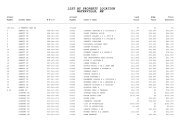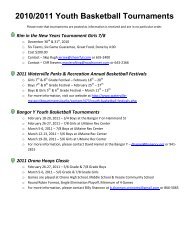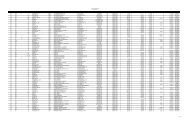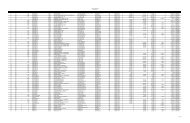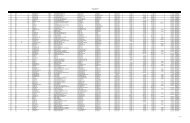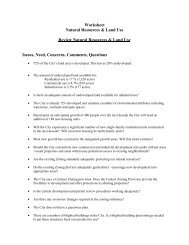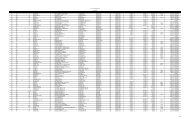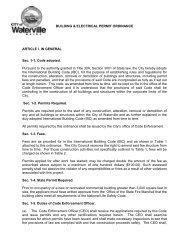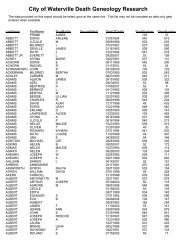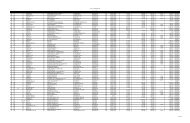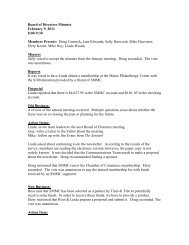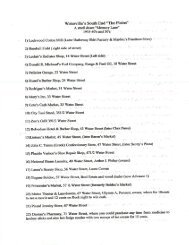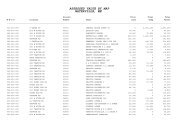Airport Master Plan 2012 - City of Waterville
Airport Master Plan 2012 - City of Waterville
Airport Master Plan 2012 - City of Waterville
You also want an ePaper? Increase the reach of your titles
YUMPU automatically turns print PDFs into web optimized ePapers that Google loves.
2, 3 and 4 are located on airport property around Taxiway „D.‟ Watershed 2 generated run<strong>of</strong>f drains<br />
northerly <strong>of</strong>f airport property. Run<strong>of</strong>f in Watershed 3 drains westerly to a drainage ditch before leaving<br />
the <strong>Airport</strong> property. Run<strong>of</strong>f in Watershed 4 drains southerly to a wide, shallow swale and then leaves<br />
airport property. All three Watersheds 2 through 4 eventually drain to the same stream that drains<br />
Watershed 1. The stream in turn empties into the Kennebec River at a location about 1.5 miles in a<br />
eastern direction from the <strong>Airport</strong>.<br />
It was determined in the environmental permit referenced above, that the proposed reduction in pavement<br />
from Runway 14-32 will mitigate any increases in on-site stormwater run<strong>of</strong>f resulting from previously<br />
identified airport projects, including T hangars in the vicinity <strong>of</strong> taxiway “D”. At that time, it was<br />
determined that the proposed development met the standards for stormwater management. However, since<br />
the projects identified in the 2004 permit do not exactly match those <strong>of</strong> the current proposed improvement<br />
projects and some <strong>of</strong> the proposed development specified in the 2004 permit application has not occurred,<br />
the proposed improvement projects will be subject to future determination and/or require an additional<br />
Application for Permit Modification that identifies if the proposed projects meet the current Maine DEP<br />
standards.<br />
The impacts to pervious surface related to all proposed development result in the addition <strong>of</strong><br />
approximately, 218,000 SF <strong>of</strong> pavement. These projects include:<br />
<br />
<br />
<br />
<br />
<br />
A new taxiway “E” which will connect taxiway “D” to taxiway “A”;<br />
An aircraft apron adjacent to the existing terminal apron;<br />
FBO building development abutting the new aircraft apron;<br />
A SRE building in the vicinity <strong>of</strong> the existing terminal; and<br />
T hangar development.<br />
Alterations to stormwater flow at the <strong>Airport</strong> could result from increasing the amount <strong>of</strong> impervious<br />
surface, however, the proposed narrowing <strong>of</strong> Runway 14-32 would <strong>of</strong>fset this by approximately 165,000<br />
SF, and the reclamation <strong>of</strong> the abandon pavement in the east quadrant <strong>of</strong> the <strong>Airport</strong> would additionally<br />
<strong>of</strong>fset this by approximately 140,000 SF. Therefore, the construction <strong>of</strong> all proposed development in<br />
conjunction with pavement removal results in an additional pervious surface <strong>of</strong> approximately 87,000 SF,<br />
or nearly 2 acres, which could result in improving the overall drainage at the <strong>Airport</strong>.<br />
It is anticipated that as airport projects progress, the impacts <strong>of</strong> additional impervious surface will<br />
concurrently be <strong>of</strong>fset by the narrowing <strong>of</strong> Runway 14-32 and/or the removal <strong>of</strong> the abandoned pavement.<br />
Furthermore, with the addition <strong>of</strong> the dry swale west <strong>of</strong> the proposed development along taxiway “D”, it<br />
is also anticipated that the required total suspended solids (TSS) removal standards associated with<br />
proposed development will be met. Actual stormwater impacts will be investigated further, and<br />
determined in a subsequent environmental analysis.<br />
5.5 U.S. Department <strong>of</strong> Transportation Act Section 4(f) Land<br />
It appears that no adverse impacts to Section 4(f)/6(f) properties (publicly owned parks, recreation areas<br />
or wildlife refuges) will occur as a result <strong>of</strong> the preferred alternative and, therefore, no measures to<br />
mitigate potential impacts resulting from the proposed action appear warranted.<br />
The <strong>City</strong> <strong>of</strong> <strong>Waterville</strong> Maine<br />
Environmental Review – Page 5-5<br />
<strong>Airport</strong> Solutions Group, LLC & The Louis Berger Group, Inc. December 2011


